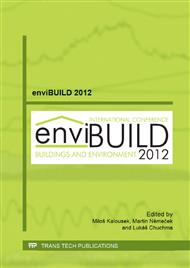[1]
X. Lv, Z. Huang, W. Zhang, P. Rao, L. Ni. Identification and characterization of filamentous fungi isolated from fermentation starters for Hong Qu glutinous rice wine brewing, J.Gen.Appl.Microbiol. 58 (2012) 33-42.
DOI: 10.2323/jgam.58.33
Google Scholar
[2]
L. Garcia-Agudo, P. Aznar-Marin, F. Galan-Sanchez, P. Garcia-Martos, P. Marin-Casanova, M. Rodriguez-Iglesias. Otomycosis due to Filamentous Fungi, Mycopathologia. 172 (2011) 307-310.
DOI: 10.1007/s11046-011-9427-5
Google Scholar
[3]
J. Paříková, I. Kučerová: How to get rid of molds. Grada publishing, spol. s r.o., Prague, 2001.
Google Scholar
[4]
R.C. Shoemaker, D.E. House: Sick building syndrome (SBS) and exposure to water-damaged buildings: Time series study, clinical trial and mechanism. Neurotoxicology and Teratology. 2006, 28, 5, 573-588.
DOI: 10.1016/j.ntt.2006.07.003
Google Scholar
[5]
Q. Deng, X. Yang, J.S. Zhang. Key factor analysis of VOC sorption and its impact on indoor concentrations: The role of ventilation, Build.Environ. 47 (2012) 182-187.
DOI: 10.1016/j.buildenv.2011.07.026
Google Scholar
[6]
M. Parizek, T.E.L. Douglas, K. Novotna, A. Kromka, M.A. Brady, A. Renzing, et al. Nanofibrous poly(lactide-co-glycolide) membranes loaded with diamond nanoparticles as promising substrates for bone tissue engineering, Int.J.Nanomed. 7 (2012) 1931-1951.
DOI: 10.2147/ijn.s26665
Google Scholar
[7]
M.F. Ashby, P.J. Ferreira, D.L. Schodek, Chapter 11 - Nanomaterials and Nanotechnologies in Health and the Environment, Nanomaterials, Nanotechnologies and Design, Butterworth-Heinemann, Boston, 2009, pp.467-500.
DOI: 10.1016/b978-0-7506-8149-0.00013-1
Google Scholar
[8]
L. Geranio, M. Heuberger, B. Nowack. The Behavior of Silver Nanotextiles during Washing, Environ.Sci.Technol. 43 (2009) 8113-8118.
DOI: 10.1021/es9018332
Google Scholar
[9]
G. Faggio, V. Modafferi, G. Panzera, D. Alfieri, S. Santangelo. Micro-Raman and photoluminescence analysis of composite vanadium oxide/poly-vinyl acetate fibres synthesised by electro-spinning, J.Raman Spectrosc. 43 (2012) 761-768.
DOI: 10.1002/jrs.3089
Google Scholar
[10]
Y. Wang, Q. Zhang, C. Zhang, P. Li. Characterization and cooperative antimicrobial properties of chitosan/nano-ZnO composite nanofibrous membranes, Food Chem. 132 (2012) 419-427.
DOI: 10.1016/j.foodchem.2011.11.015
Google Scholar
[11]
D. Chmielewska, A. Lukasiewicz, J. Michalik & B. Sartowska (2006). Silica materials with biocidal activity. Nukleonika, 51, S69-S72.
Google Scholar
[12]
T. Reponen, J. Lockey, D.I. Bernstein, S.J. Vesper, L. Levin, G.K.K. Hershey, G. LeMasters, (2012). Infant origins of childhood asthma associated with specific molds. Journal of Allergy and Clinical Immunology, 130(3), 639-+.
DOI: 10.1016/j.jaci.2012.05.030
Google Scholar
[13]
M. Rai, A. Yadav, A. Gade, Silver Nanoparticles as A New Generation of Antimicrobial, Biotechnology Advances, Vol. 27, No.1, January-February 2009, pp.76-83.
DOI: 10.1016/j.biotechadv.2008.09.002
Google Scholar
[14]
M. Catauro, M.G. Raucci, F. de Gaetano and A. Marotta, Antibacterial and Bioactive Silver Containing Na2O·CaO·2SiO2 Glass Prepared by Sol Gel Method, Journal of Materials Science: Materials in Medicine, Vol.15, No.7, July 2004, pp.831-837.
DOI: 10.1023/b:jmsm.0000032825.51052.00
Google Scholar
[15]
J.H. Crabtree, R.J. Burchette, R.A. Siddiqi, I.T. Huen, L.L. Handott, A. Fishman, The Efficacy of Silver-Ion Implanted Catheters in Reducing Peritoneal Dialysis-Related Infections, Peritoneal Dialysis International, Vol. 23, No.4, July- August 2003, pp.368-374.)
DOI: 10.1177/089686080302300410
Google Scholar
[16]
K. Malachová, P. Praus, Z. Rybková & O. Kozák, (2011). Antibacterial and antifungal activities of silver, copper and zinc montmorillonites. Applied Clay Science, 53(4), 642-645.
DOI: 10.1016/j.clay.2011.05.016
Google Scholar


